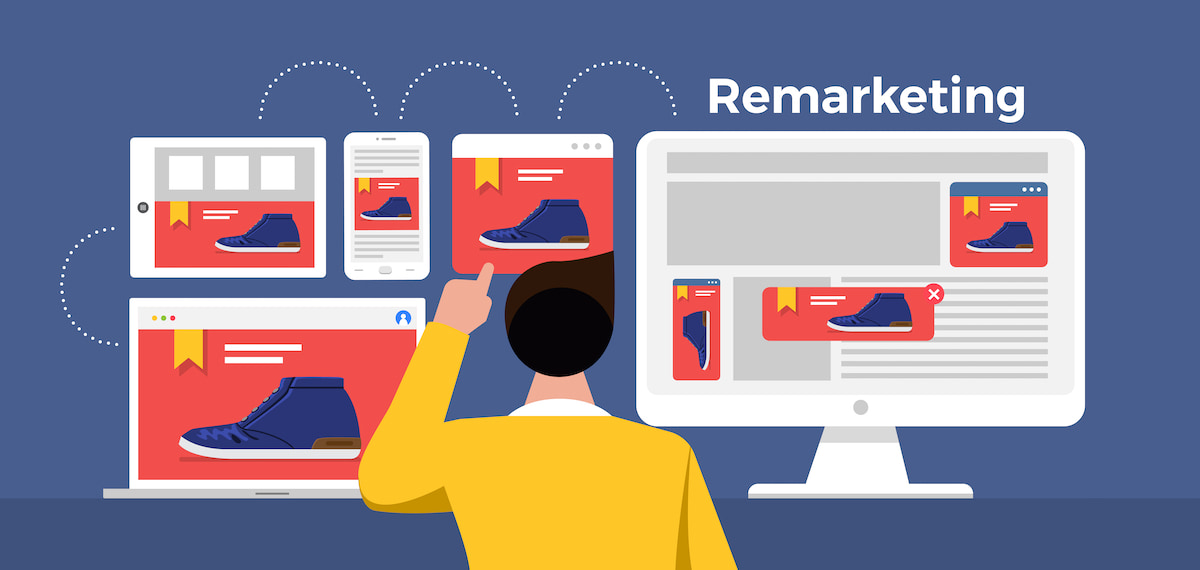What is Display Advertising? The complete guide for beginners
Digital advertising is changing the marketing industry. Data shows that Digital advertising will account for more than half of all advertising sales in the United States by 2021, compared with just 40.5% in 2017. Competition in this evolving market requires a strong grasp of digital marketing in all its forms. One of the most effective ways to get started is with Display Advertising.
Understanding the nature of Display Advertising can be much easier than you might imagine. But how to master this method of advertising is a big challenge. And the following article may help plan your digital marketing strategy.
What is display advertising?

Display Advertising is a type of online advertising that visualizes a product or a service through images, videos, texts, and logos.
Read more:
- 6 Biggest Benefits of Advertising
- Is False Advertising illegal?
- What is native advertising?
- What is newspaper advertising?
Types of display advertising
Display Advertising varies a lot in terms of the audience they target and the way they work. Below is a breakdown and explanation of some of the popular Display Advertising types today.
Remarketing Ads

Remarketing is a term referring to approaching customers through Display Advertising. As you may have noticed, Remarketing uses ads that are re-displayed for customers who have visited the Website, or a landing page (of your business) in other online environments. This advertising campaign aims to increase the engagement of customers with the brand of the business.
According to Acckey Interactive, 91% of consumers like to buy from brands remembering their preferences and offering incentives based on their needs. Remarketing ads meet that, and this is how they become popular.
Retargeting can also be understood as behavioral remarketing. It conveys the most familiar banner ads to a featured client file. This customer file is built based on customer behavior on your Website, with specific evaluation and classification criteria.
It is entirely possible to build different customer files according to their behavior and how they interact with your business website/landing page. For example, you can group customers who regularly check the product’s price without purchasing on the website.
Using retargeting, in this case, is a smart idea. You can ultimately push a banner that can convey a specific message, how the above group of customers can return to your shop and complete the product order.
Personalized Ads

Personalized Advertising, also known as Interest-Based Advertising, is a powerful tool that improves the ad’s relevance to users and increases the ROI for advertisers. Personalized Advertising works by using online user data to target your target audience with more relevant advertising content, thereby improving user experience and the advertiser.
The purpose of personalization is to use data to make it easy for customers to find and buy their favorite products in a familiar way, and to buy whenever they want. For businesses, Personalized Advertising helps businesses set up the right messages and conversational methods to reach target customers; increase customer satisfaction, customer lifetime value; save costs, and improve revenue.
The core elements of Personalized Ads are Target customers, Demand for the product, Content, Design, and Channel.
Before Big Data or AI developed today, personalization was only practiced at four levels:
Level 1: Target a target audience based on a combination of needs or wants and a broad geographic location (country, region).
Level 2: Target a target audience based on a combination of needs or wants and a more specific geographic location (city, province).
Level 3: Target your target audience based on a combination of needs or wants, microgeographic location (zip code), and demographic information (age, gender, income, etc.).
Level 4: Target your target audience based on a combination of needs or wants, microgeographic location, general demographic information, and personal interests (sports, travel, technology, etc.).
With the support of real-time data analysis technologies, personalization is opened up to 2 more levels as follows:
Level 5: Targeting based on a combination of needs or wants, micro geolocation, advanced demographic information (political opinion, brand loyalty, type of vehicle, etc.), specific interests (Genre of music, celebrity, …), and purchase intent (keyword search).
Level 6: Target target customers based on a combination of needs or wants, geographic accuracy (GPS), advanced demographic information, specific interests, purchase intentions, and models of Historical behavior (purchase history, voting participation, websites visited, etc.).
Contextually Targeted Ads

Contextual Advertising is a form of advertising on websites or other media (mobile phones) aimed at users based on the context of the article, circumstances, geographical location, the user’s time to access the ad, and the visitor’s habits of access.
Contextually Targeted Ads identifies the content on the website and determines the user’s use circumstances to bring out the advertisement that best suits the user’s needs.
Contextual ads display technology that has helped advertisers to automate the ad analysis and planning process. Because display ads are related to the user’s content and usage circumstances, the advertising message is user-friendly, useful to users, increases the view rate, clicks on the ad, helps businesses optimize costs and revenue optimization websites.
Contextual display advertising technology has features: automatic user analysis, choosing whom to display ads, geographic location, budget management, and an online pricing system. At the same time, the fee system is flexible. It includes charging according to the number of impressions (CPM - Cost Per Mile), the value of each click (CPC - Cost Per Click), or according to the user’s interaction on the advertisement (CPA). CPA has helped businesses optimize advertising costs while ensuring its effectiveness.
Examples of display advertising
Here are a few examples of Display Advertising, from different famous brands, on the three basic types: Static image banners, GIFs, and Animated HTML5.
Static Image banners


GIFs


Animated HTML5


Learn more:
- Toyota Marketing Strategy
- Zara Marketing Strategy
- How Much Does Facebook Ads Cost?
- Maybelline Marketing Strategy & Ads
How does display advertising work?
Step 1: Design
Firstly, to create your first banner ads, you need to assemble images and texts by using the HTML5 ad builder tool. This acts as a format for all the sizes of the ad in your marketing campaign.
A good display ad needs:
- Color representing your brand and the right feeling
- Readable copy
- High quality and relevant images
- Outstanding logo
- A call-to-act (CTA) button

Step 2: Scale
In online advertising, sizes matter. It’s critical to put a lot of thoughts on the banner ad sizes that generate the most amount of impressions, clicks, and sales.
The most common Display Ad sizes:
- 250 x 250 - Square
- 200 x 200 - Small Square
- 468 x 60 - Banner
- 728 x 90 - Leaderboard
- 300 x 250 - Inline Rectangle
- 336 x 280 - Large Rectangle
- 120 x 600 - Skyscraper
- 160 x 600 - Wide Skyscraper
- 300 x 600 - Half-Page Ad
- 970 x 90 - Large Leaderboard
The Top Performing Ad Sizes:
- 300 x 250 – Medium rectangle
- 336 x 280 – Large rectangle
- 728 x 90 – Leaderboard
- 300 x 600 – Half page or large skyscraper
- 320 x 50 – Mobile leaderboard

Step 3: Publish
Last but not least, the most important part is publishing. If you base your display ads on these sizes below, you can be sure that most devices will display your ads correctly when your ad is served.
Since uploading display advertising individually is such a tiresome task that it is worth avoiding. You can directly benefit from ad networks and ad exchanges by using a creative management platform (CMP). Thus, you can publish and control ads at the push of a button.
Why you should consider display ads in your marketing campaign

Display Ads support brand awareness
Display advertising helps businesses to stand out to users and attract their attention. The visual of display ads also advance your business by facilitating brand identity. Users need to read the text on the ad and then click through to access a landing page, which communicates the business and its offer. Therefore, a user can gather information on your brand simply by seeing your display ad, no click necessary.
Effectively target with Display Ads
Moreover, you can create specific information for your display ads: which sites they appear on and their geographic area. Targeting your display ads helps you maximize your expense.
That display ads target specific audiences does not mean they limit the visibility of your business online. Display ads give you the chance to appear on websites that are highly trafficked and related to your ad’s offer. Display ads promote your business by getting you in front of a high range of people, even if they’re not searching.
Display Ads provide data
Display advertising platforms offer this benefit to your business. With the data it provides, you can know exactly how many times your ad has been clicked.
Display Ads support etargeting
Besides standard targeting capabilities, display advertising also allows for retargeting. With retargeting, you still can reach out to people who had visited your website before and expressed concern in your business, and even reach more potential customers.
What makes a successful display advertising?
Landing Page

Landing pages play an important role in any Display Advertising campaign. The goal here is to drive traffic to the landing page, while still reaping the benefits of the display advertising campaign.
Banner ads as an auxiliary tool for landing pages. Basically, the external identity of the banner and the landing page must be the same. This makes visitors not feel “overwhelmed” when clicking on the banner pointing to the landing page. Use consistent design, elements, colors, and fonts between the banner and the landing page.
The content of the landing page should be consistent with the message the banner conveys to the customer. This creates a seamless experience for the user.
Real-time Bidding

RTB is when an advertiser buys ad impressions on websites at the time the target user visits the website and sees the ad. With RTB, businesses use the demand-side platform (DSP) to help them decide the time, area, and the bidding price they are willing to pay. Even more superior, businesses are also allowed to choose to display banners to a certain target group of users, or to users who are searching for products/services corresponding to their supply.
For example, an internet user regularly uses Coc Coc to access financial pages. At a certain point, when this user opens a browser, Coc Coc’s banner auction system will check how many banners are wanting to display ads to this user.
Demand-side platforms and real-time bidding help advertisers to target online users most likely to purchase their product or service, giving them the most bang for their buck.
Simple Design
Display ads are meant to stand out, but not in a distracting way. Use a clean design with eye-catching visual elements, such as graphics, large and small fonts, complementary colors, and catchy messaging.
Clear Information
To build brand awareness, your ad needs to be easily identified as soon as customers see your ad. Your business name and/or logo should be on there, and it should be clear right off the bat what you have to offer. This helps potential customers recognize you to know right away if your business is relevant to what they are looking for.
How to measure display advertising?
Impressions
Impression is a statistical indicator of how often an ad is viewed by visitors without clicking on an ad. An impression is simply a view. Impression is determined by the number of advertisements displayed on a Google search engine or other Internet sites. An impression is an estimate of how many people a particular ad is reaching and can be calculated differently depending on how it is placed on the page.
Recording a large number of impressions means that your ad is reaching a wide audience. More views increase the chances for conversion. Impressions can help build brand awareness. The more creative the ad is, the longer people will remember its message.
Reach
Reach tells how many people see an ad. For display advertising, this KPI measures the number of unique views a particular ad receives. High reach means your article has reached a lot of people and vice versa.
Keeping an eye on reach metrics is essential for your brand awareness. However, if the wrong person keeps seeing your ad, you may be missing out on the one that truly concerns. The more people experience ad fatigue, the more you need to consider to tailor your plan to reach your target market.
Click-through rate
CTR shows how many people click on your ad after seeing it. In Google Adwords and Facebook Ads, the CTR metric measures the ratio of its ad clicks to its impressions.
It’s calculated by the ratio of impressions to clicks. For instance, if your ad receives 1,000 impressions and has 18 clicks, the click-through rate is 1.8%.
If you achieve a high CTR, it will bring success to your PPC (Pay-per-click) advertising. It directly affects your quality score and how much you pay each time someone clicks on your ad. If your click-through rate seems low, then you may want to test new ad creative.
Conversion rate
Conversion rate is the percentage of the number of conversions divided by the total number of visitors.
For example, if an eCommerce website gets 200 visitors in a month and has 50 products sold. The conversion rate will be 50 divided by 200 or 25%.
A conversion can be any action you want the user to perform. It includes anything from clicking a button to making a purchase and becoming a customer.
Related posts:
- 13 Types of Advertising
- The Zara’s 0$ Advertising Strategy
- Best FREE Advertising sites
- How to Set Up Google Shopping for your Shopify
Wrap-up
Display Advertising is a form of advertising that is being used by many businesses in digital marketing. It has to be said that Display Ads works more effectively than most other forms of advertising.
Honestly, it’s very engaging, and it spreads your brand in a very positive direction. When you combine Display Ads with other marketing techniques, you can reach potential customers at every level of their journey. But how to master it is a big challenge for businesses. Building a powerful Display Advertising online campaign, analyzing, measuring, and optimizing the campaign will help companies achieve excellent digital marketing results if on the right track.
New Posts

How To Set Up Google Analytics 4 For Your BigCommerce Store






